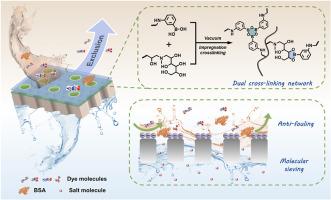通过顺序硼砂/硼酸盐交联策略调整高性能松散纳滤膜的孔隙结构和亲水性
IF 9
1区 工程技术
Q1 ENGINEERING, CHEMICAL
引用次数: 0
摘要
具有精确分子筛分和良好渗透性的松散纳滤(LNF)膜是染料/盐分离的理想选择,其中调整微孔结构对于增强性能至关重要。在此,通过在PAN衬底上交联聚羟基聚合物和硼酸修饰聚合物,开发了一种简单的“逐层”方法来构建LNF膜。顺序真空辅助浸渍涂层实现了双重交联:脱水诱导的B-OH缩合形成硼氧,以及残留的B-OH和邻近的二醇之间形成硼酸酯。通过调节浸涂浓度和交联顺序,实现了选择性层孔径和亲水性的精确调节。优化后的膜具有良好的渗透性(36.2 L m−2 h−1 bar−1)和选择性(NaCl/DR23分离系数高达1278.3),对多种污染物具有优异的抗污染性能(FRR > 94.1%)。值得注意的是,水稳定型硼氧-硼酸盐聚合物层在连续运行过程中保持了稳定的分离性能。本文章由计算机程序翻译,如有差异,请以英文原文为准。

Tuning pore structure and hydrophilicity of high-performance loose nanofiltration membrane via sequential boroxine/boronate crosslinking strategy
Loose nanofiltration (LNF) membranes with precise molecular sieving and good permeability are ideal for dye/salt separation, where tuning the microporous structure is essential for performance enhancement. Herein, a facile “layer-by-layer” approach via cross-linking of polyhydroxy polymer and boronic acid-decorated polymers on PAN substrates was developed to construct LNF membranes. Sequential vacuum-assisted dip-coating enabled dual cross-linking: dehydration-induced condensation of B–OH to form boroxine, and boronate ester formation between residual B–OH and vicinal diols. Precise tuning of selective layer pore size and hydrophilicity was achieved by regulating the dip-coating concentration and cross-linking sequences. The optimized membrane exhibited excellent permeability (36.2 L m−2 h−1 bar−1) and high selectivity (NaCl/DR23 separation factor up to 1278.3), along with outstanding anti-fouling performance (FRR >94.1 %) against multiple contaminants. Notably, the water-stable boroxine-boronate polymer layer maintained stable separation performance during continuous operation.
求助全文
通过发布文献求助,成功后即可免费获取论文全文。
去求助
来源期刊

Journal of Membrane Science
工程技术-高分子科学
CiteScore
17.10
自引率
17.90%
发文量
1031
审稿时长
2.5 months
期刊介绍:
The Journal of Membrane Science is a publication that focuses on membrane systems and is aimed at academic and industrial chemists, chemical engineers, materials scientists, and membranologists. It publishes original research and reviews on various aspects of membrane transport, membrane formation/structure, fouling, module/process design, and processes/applications. The journal primarily focuses on the structure, function, and performance of non-biological membranes but also includes papers that relate to biological membranes. The Journal of Membrane Science publishes Full Text Papers, State-of-the-Art Reviews, Letters to the Editor, and Perspectives.
 求助内容:
求助内容: 应助结果提醒方式:
应助结果提醒方式:


